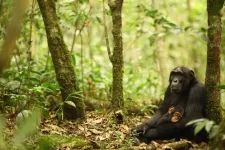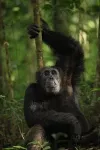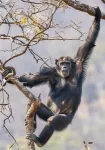(Press-News.org) Chimpanzees bear genetic adaptations that help them thrive in their different forest and savannah habitats, some of which may protect against malaria, according to a study by an international team led by UCL researchers.
Chimpanzees are our closest living relatives, sharing over 98% of their DNA with humans, and the scientists say that their findings, published in Science, can not only teach us about our own evolutionary history, but also about the biology of malaria infection in humans.
Chimpanzees are endangered due to habitat destruction, poaching and infectious disease. The results of this study could also inform conservation as they suggest that climate and land use changes will likely have different impacts on different chimpanzee groups.
Lead author Professor Aida Andrés (UCL Genetics Institute) said: “There are just a few hundred thousand chimpanzees alive, but they are found across very different landscapes from east Africa to the far west of the continent, including dense tropical rainforests and open areas of woodland and savannah. This makes them quite unique, because except for humans, all other apes live exclusively in forests.
“Here we have shown that besides acquiring behavioural adaptations, different chimpanzee populations have evolved genetic differences to survive in their different local habitats.
“As chimpanzees are facing threats across their range, including environmental changes to the climate and displacement due to human pressures, it is important that their genetic diversity is conserved to maintain their resilience and ensure the long-term survival of this intelligent and fascinating species.”
To study genetic adaptation, the international team of researchers, from institutions across Africa, Europe and North America, needed to obtain DNA from the endangered and highly elusive wild chimpanzees without disturbing them. To do so, they used faecal samples that were collected as part of the Pan African Programme: The Cultured Chimpanzee (PanAf). State-of-the-art laboratory and computational methods enabled the scientists to study the chimpanzee DNA in these samples and perform the largest study of local adaptation in wild endangered mammals to date.
The researchers analysed the exomes (the protein-coding part of the genome) from 828 wild chimpanzees, 388 of which were included in the final analysis, representing 30 different populations of chimpanzees across the geographic and ecological range of the four chimpanzee subspecies. The scientists compared the genetic information to data about the local environment each chimpanzee population lives in, identifying genetic variants that stand out as being much more frequent in certain regions than others, and that likely confer a benefit to those carrying the genetic variant in particular habitats.
The scientists found evidence of genetic adaptation in genes related to certain pathogens (disease-causing microorganisms) among the chimpanzees living in forests, where there is a high concentration of pathogens, with the strongest evidence found in genes linked to malaria. This includes two genes that are also known to be responsible for adaptation and resistance to malaria in humans: GYPA and HBB, the latter being responsible for sickle cell anaemia in humans.
The findings suggest that malaria is likely a significant disease for wild forest chimpanzees and that adaptation to the malaria parasite has happened, independently, through changes in the very same genes in chimpanzees and humans.
First author Dr Harrison Ostridge (UCL Genetics Institute) said: “The close genetic similarities between the great apes have resulted in diseases jumping from apes to humans, such as with malaria and HIV/AIDS, so studying wild chimpanzees is extremely useful to understand these and other shared infectious diseases in humans, and could help to develop new treatments or vaccines.
“Finding evidence of adaptation to malaria in chimpanzees linked to the same genes that affect malaria resistance in humans is striking from an evolutionary point of view, as it suggests there may be limited ways that we can evolve resistance to the malaria parasite.”
The study suggests that chimpanzees have also adapted to their savannah habitats, which have higher temperatures, lower rainfall and less food availability. This shows that studying savannah chimpanzees may shed light on how human ancestors adapted to similar habitats millions of years ago, when they first moved from the African forest to the savannah.
Co-author and PanAf co-director Dr Hjalmar Kuehl (Senckenberg Museum of Natural History, Germany) commented: “This ground-breaking study on chimpanzee local adaptations could not be accomplished without the extraordinary collaboration of an international team of scientists who worked tirelessly to collect non-invasive data, including faecal samples, from countries across the chimpanzee range."
Co-author and PanAf co-director Dr Mimi Arandjelovic (Max Planck Institute for Evolutionary Anthropology, Germany) added: “We further welcome everyone interested in our research to contribute as community scientists at ChimpandSee.org, where one can help annotate videos collected alongside the genetic samples from across the chimpanzee range."
END
Chimpanzees are genetically adapted to local habitats and infections such as malaria
2025-01-09
ELSE PRESS RELEASES FROM THIS DATE:
Changes to building materials could store carbon dioxide for decades
2025-01-09
Replacing conventional building materials with materials modified to store carbon dioxide could move the planet closer to net-zero greenhouse gas emissions, according to a new study by Elisabeth Van Roijen and colleagues. The researchers calculate that full replacement of conventional building materials with these CO2-sequestering alternatives could store as much as 16.6 ± 2.8 gigatons of CO2 each year – an equivalent to about 50% of the anthropogenic CO2 emissions in 2021. Removing carbon dioxide from the atmosphere, along with decreasing emissions, is important for slowing ...
EPA finalized rule on greenhouse gas emissions by power plants could reduce emissions with limited costs
2025-01-09
In this Policy Forum, John Bistline and colleagues analyze the potential impacts of the U.S. Environmental Protection Agency’s finalized power plant rules regarding greenhouse gas emissions. Using nine models of the U.S. electric sector and energy systems, the researchers found that the rules would speed up the reduction of emissions in the power sector. Under the rules, the levels of carbon dioxide emitted by the sector would be 61%-81% below 2005 levels by 2040. Under current policies, emission levels would be 51% to 83% below 2005 levels by 2040, ...
Kangaroos kept a broad diet through late Pleistocene climate changes
2025-01-09
Samuel Arman and colleagues’ close examination of tooth microwear among living and extinct kangaroo species suggests that most of the species living in Australia during the Late Pleistocene had a broad, generalist diet rather than being specialized grazers. This broad diet likely allowed them to survive the glacial-interglacial cycles that drove fluctuations in vegetation on the continent. The findings add more evidence to the idea that human hunting, rather than failure to adapt to climate changes, ...
Sex-specific neural circuits underlie shifting social preferences for male or female interaction among mice
2025-01-09
Male and female mice both prefer social interaction with female mice under normal conditions, but both switch to preferring males when their survival is threatened, according to a new study by Anqi Wei and colleagues. These preferences are mediated by different neuronal circuitry in male and female mice related to dopaminergic neurons in the brain’s ventral tegmental area, the researchers found. The findings offer a clearer picture of the underlying biology of socio-sexual preferences. These preferences are essential for successful reproduction, ...
The basis of voluntary movements: A groundbreaking study in ‘Science’ reveals the brain mechanisms controlling natural actions
2025-01-09
Eight years of work. A collaboration between the Laboratory of Neuroethology of Non-Human Primates of the Department of Medicine and Surgery of the University of Parma, led by Luca Bonini, and a team from the Biorobotics Institute of the Sant'Anna School of Pisa, coordinated by Alberto Mazzoni, principal investigator at the Computational Neuroengineering Lab, with the contribution of Silvestro Micera, professor in Bioingeneering. Support from three projects funded by the European Research Council (ERC) and as many Italian national projects, including MNESYS and BRIEF. These are just some of the elements of a groundbreaking study published in ...
Storing carbon in buildings could help address climate change
2025-01-09
Construction materials such as concrete and plastic have the potential to lock away billions of tons of carbon dioxide, according to a new study by civil engineers and earth systems scientists at the University of California, Davis and Stanford University. The study, published Jan. 10 in Science, shows that combined with steps to decarbonize the economy, storing CO2 in buildings could help the world achieve goals for reducing greenhouse gas emissions.
“The potential is pretty large,” said Elisabeth Van ...
May the force not be with you: Cell migration doesn't only rely on generating force
2025-01-09
By Beth Miller
In mechanobiology, cells’ forces have been considered fundamental to their enhanced function, including fast migration. But a group of researchers in the McKelvey School of Engineering at Washington University in St. Louis has found that cells can generate and use lower force yet move faster than cells generating and using high forces, turning the age-old assumption of force on its head.
The laboratory of Amit Pathak, professor of mechanical engineering and materials science, found that groups of cells moved faster with lower force when adhered to soft surfaces with aligned collagen fibers. Cells have been thought to continually generate ...
NTU Singapore-led discovery poised to help detect dark matter and pave the way to unravel the universe’s secrets
2025-01-09
Researchers led by Nanyang Technological University, Singapore (NTU Singapore) have developed a breakthrough technique that could lay the foundations for detecting the universe’s “dark matter” and bring scientists closer than before to uncovering the secrets of the cosmos.
The things we can see on Earth and in space – visible matter like rocks and stars – make up only a small portion of the universe, as scientists believe that 85 per cent of matter in the cosmos comprises invisible dark matter. This mysterious substance ...
Researchers use lab data to rewrite equation for deformation, flow of watery glacier ice
2025-01-09
AMES, Iowa – Neal Iverson started with two lessons in ice physics when asked to describe a research paper about glacier ice flow that has just been published by the journal Science.
First, said the distinguished professor emeritus of Iowa State University’s Department of the Earth, Atmosphere, and Climate, there are different types of ice within glaciers. Parts of glaciers are at their pressure-melting temperature and are soft and watery.
That temperate ice is like an ice cube left on a kitchen counter, with meltwater ...
Did prehistoric kangaroos run out of food?
2025-01-09
Prehistoric kangaroos in southern Australia had a more general diet than previously assumed, giving rise to new ideas about their survival and resilience to climate change, and the final extinction of the megafauna, a new study has found.
The new research, a collaboration between palaeontologists from Flinders University and the Museum and Art Gallery of the Northern Territory (MAGNT), used advanced dental analysis techniques to study microscopic wear patterns on fossilised kangaroo teeth.
The findings, published in Science, suggest that many species of kangaroos were generalists, able to adapt to diverse diets in response to environmental changes.
More ...







